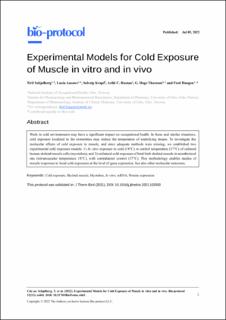| dc.contributor.author | Schjølberg, Tiril | |
| dc.contributor.author | Asoawe, Lucia | |
| dc.contributor.author | Krapf, Solveig Astrid | |
| dc.contributor.author | Rustan, Arild Christian | |
| dc.contributor.author | Thoresen, G. Hege | |
| dc.contributor.author | Haugen, Fred | |
| dc.date.accessioned | 2023-02-06T13:09:08Z | |
| dc.date.available | 2023-02-06T13:09:08Z | |
| dc.date.created | 2022-08-12T09:22:10Z | |
| dc.date.issued | 2022 | |
| dc.identifier.citation | Bio-protocol. 2022, 12:e4461 (13), 1-10. | |
| dc.identifier.issn | 2331-8325 | |
| dc.identifier.uri | https://hdl.handle.net/11250/3048586 | |
| dc.description.abstract | Work in cold environments may have a significant impact on occupational health. In these and similar situations, cold exposure localized to the extremities may reduce the temperature of underlying tissues. To investigate the molecular effects of cold exposure in muscle, and since adequate methods were missing, we established two experimental cold exposure models: 1) In vitroexposure to cold (18degreeC) or control temperature (37degreeC) of cultured human skeletal muscle cells (myotubes); and 2) unilateral cold exposure of hind limb skeletal muscle in anesthetized rats (intramuscular temperature 18degreeC), with contralateral control (37degreeC). This methodology enables studies of muscle responses to local cold exposures at the level of gene expression, but also other molecular outcomes. | |
| dc.description.abstract | Experimental Models for Cold Exposure of Muscle in vitro and in vivo | |
| dc.language.iso | eng | |
| dc.title | Experimental Models for Cold Exposure of Muscle in vitro and in vivo | |
| dc.title.alternative | Experimental Models for Cold Exposure of Muscle in vitro and in vivo | |
| dc.type | Peer reviewed | |
| dc.type | Journal article | |
| dc.description.version | publishedVersion | |
| dc.source.pagenumber | 1-10 | |
| dc.source.volume | 12:e4461 | |
| dc.source.journal | Bio-protocol | |
| dc.source.issue | 13 | |
| dc.identifier.doi | 10.21769/BioProtoc.4461 | |
| dc.identifier.cristin | 2042588 | |
| cristin.ispublished | true | |
| cristin.fulltext | original | |
| cristin.qualitycode | 1 | |
